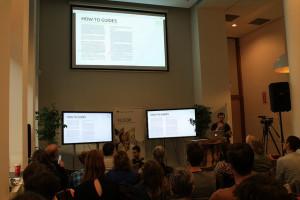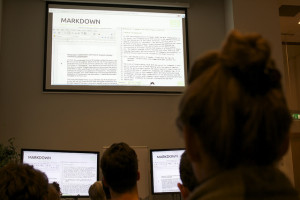In the final showcase of the Digital Publishing Toolkit event in November 2014, Michael Murtaugh presented on behalf of the rest of the Institute of Network Cultures subgroup – that includes Joost Kircz, Silvio Lorusso, Miriam Rasch and Kimmy Spreeuwenberg – to answer the question:
How can small edition, low budget publishing houses edit, design, and develop a new, hybrid workflow for editing, designing and developing?
The INC subgroup has developed and optimised a workflow for print and digital publications to make the process of publishing on different platforms and in different formats easier and more efficient. Murtaugh gave a concise overview of their “hybrid workflow” by firstly explaining what is meant by “hybridity”. Within the publishing process, hybridity refers to a multitude of different things, including different screen sizes and technologies as well as print vs. digital.
Murtaugh stressed that “hybridity” also denotes the diverse dynamics of different reading practices. People read in an increasing variety of ways and therefore associate different devices with distinct reading situations. For example, along with people believing that the physical book can never be replaced, there are those that feel that reading off a phone is ideal in some situations whereas using an e-reader or a tablet is appropriate in other contexts. Therefore, it is interesting to think of e-readers not only in relation to the conventional idea of “a book” but also in relation to other electronic devices.
The dynamics of different reading practices and print or digital devices therefore demands hybridity in the practices of publishing and the goal of the INC subgroup was to connect the existing publishing practices and to suggest new ways of working. Rather than regarding roles in isolation, e.g. viewing the author, editor, designer and developer as separate entities, the aim was to build bridges and connect the different roles through the tools being used and through a feedback system of “talking back to each other”. In this way, could new ouptuts then influence and be fed back into, for example, new ways of writing?
Through their own workflow for this project, the INC subgroup organised monthly work sessions in order to create situations where team members could look over each other’s shoulders to fully understand what each person was doing and how they were doing it. The group could experience first hand the benefits and challenges of fine-tuning a hybrid workflow, and could create a system that addresses the challenges of a dynamic publishing process through being both structured and yet flexible.
The creation of “How-to & Style Guides”:
 Each member of the publishing process (writer, designer, editor, developer) generally uses their own tools and their own ways of working, i.e. different formats with different kinds of interfaces leading to different ways of imagining what the text or book will be. Murtaugh explains that through the INC subgroup’s How-to and Style Guides, and running workshops in which the roles of editors, designers and developers overlap, the digital publication is not simply added onto the end of the existing print-centred publishing workflow, but can already inform each step of the process. The idea of constant feedback and output influencing each step of the process breaks down the linearity of the workflow and creates single source, multi-format publishing. By bridging practices, each member of the workflow can work using the same standard set of style features or even avoiding certain formatting features that would make the process easier in the long run.
Each member of the publishing process (writer, designer, editor, developer) generally uses their own tools and their own ways of working, i.e. different formats with different kinds of interfaces leading to different ways of imagining what the text or book will be. Murtaugh explains that through the INC subgroup’s How-to and Style Guides, and running workshops in which the roles of editors, designers and developers overlap, the digital publication is not simply added onto the end of the existing print-centred publishing workflow, but can already inform each step of the process. The idea of constant feedback and output influencing each step of the process breaks down the linearity of the workflow and creates single source, multi-format publishing. By bridging practices, each member of the workflow can work using the same standard set of style features or even avoiding certain formatting features that would make the process easier in the long run.
Using a set of hybrid tools:
 In developing the hybrid workflow, a set of tools was put together (namely, Markdown, Git, Pandoc and Make). These are tools that come from a long history of programming practices and are therefore very robust. In addition, because lots of different programmers work with them, they are very flexible. For example, the choice to use Markdown means that the text is reduced to the very core of what it is. There are no stylistic enhancements or automatic rendering of the text (as is common in word processing, for instance). The text is a ‘clean’ source that can then be interpreted by the designer for the medium specific elements of, for example, different devices for reading.
In developing the hybrid workflow, a set of tools was put together (namely, Markdown, Git, Pandoc and Make). These are tools that come from a long history of programming practices and are therefore very robust. In addition, because lots of different programmers work with them, they are very flexible. For example, the choice to use Markdown means that the text is reduced to the very core of what it is. There are no stylistic enhancements or automatic rendering of the text (as is common in word processing, for instance). The text is a ‘clean’ source that can then be interpreted by the designer for the medium specific elements of, for example, different devices for reading.
Looking ahead
Murtaugh ended the showcase by looking ahead to where the development of a hybrid workflow and EPUBs can be taken.
– An EPUB player is currently in development, which is a way to look at an EPUB online in a browser without having to generate a different html version. Through the player, an EPUB can be embedded into a website and pages can also be bookmarked and then exported as a separate EPUB. Murtaugh referred to this as being “kind of like a photocopier for the book”, whereby the EPUB you export is not a perfect publication, but it is still very useful for yourself (just like the pages of a book you photocopy).
– Secondly, Murtaugh gave a brief overview of having a hybrid editor, which is an attempt to make something that is in between the different kinds of working/publishing interfaces and tools we normally see. It is an integrated tool whose different parts come from somewhere else (e.g. from other open source tools), but they are all brought into the same interface. Murtaugh, ended the showcase by claiming that it is exciting to think of interfaces that can offer this kind of hybridity and functionalities.


